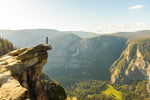Patrick Kelley
Backpacking Checklist: 7 Things to Do Before Your Next Trip
Regardless of where you’re headed, your backpack is your best friend. When backpacking, you want to take everything you need and nothing more. No matter how strong you are, the last thing you want to do is haul a 40-pound backpack around with you all day long. We’ve put together a backpacking checklist to help get you ready for your next trip.
1. Choose the right backpack - The backpack that you should bring depends on how long your trip is for and what the weather will be like. If you’re not sure how long you’re going for, it’s always better to overpack.
If your trip is less than six weeks...
- in hot weather, use a 30-40L pack
- in cold weather, use a 40-50L pack
If your trip is more than six weeks…
- in hot weather, use a 45-55L pack
- in cold weather, use a 55-65L pack
2. Start with the basics - There are some things you have no choice but to bring along with you, so those should be at the top of your packing priority list. And no, beer is not a priority (unless you’re backpacking to your buddy’s house for Sunday night football). You should be bringing a med kit, food, and water. Check out Mission 13: The New Welcome Box for the basic necessities.
3. Cut the weight down - After packing the essentials, add in anything else you may need (emphasis on need). This depends on the season of the trip, the type of trip, and any other special circumstances that require specific tools. If it doesn’t fall into one of these categories, then you don’t need it. Keep in mind that your pack should be about ⅓ of your weight when it’s filled with gear, so choose what you pack wisely.
4. Distribute the weight - Imagine being lopsided throughout your whole trip. You’ll definitely come home with an achy back. The heaviest items should be put close to your back so that they’re between your shoulder blades, shifting the weight onto your hips and not straining your back. The lightest items should go at the bottom and top of the pack. Put things that you don’t need that often on the bottom, and things that you use daily at the top for easy access.
5. Add front attachments - Some things just won’t fit inside your pack no matter how hard you try to shove everything in there. Most hiking packs have adjustable straps on the outside along the front, top, and sides. Take advantage of these loops and add in things like a sleeping bag or extra jacket.
6. Strap yourself in - After you have everything packed up and ready to go, make sure that your straps are adjusted correctly and that the backpack feels comfortable while on. Every backpack should have three straps that go around your shoulders, chest, and hips. If something feels uncomfortable, make the adjustment before you head out on the trail. Better to solve the problem now than halfway through the trip.
7. Double check - It never hurts to double check that you have everything you need, especially when you’re probably going to have limited access to extra resources during your trip. No matter how experienced you are, you could easily leave something important behind. If you realized that you’re missing some really important gear, don’t worry - we’ve got all of the essentials and more right here.
At the end of the day, you want to make sure you set yourself up for your trip to run smoothly. The last thing you want is to find yourself in a situation that you could’ve avoided. Just take these extra steps to prep for your trip!
And if you're interested in what to bring on your next camping trip, then check out this article for a list of camping necessities!









